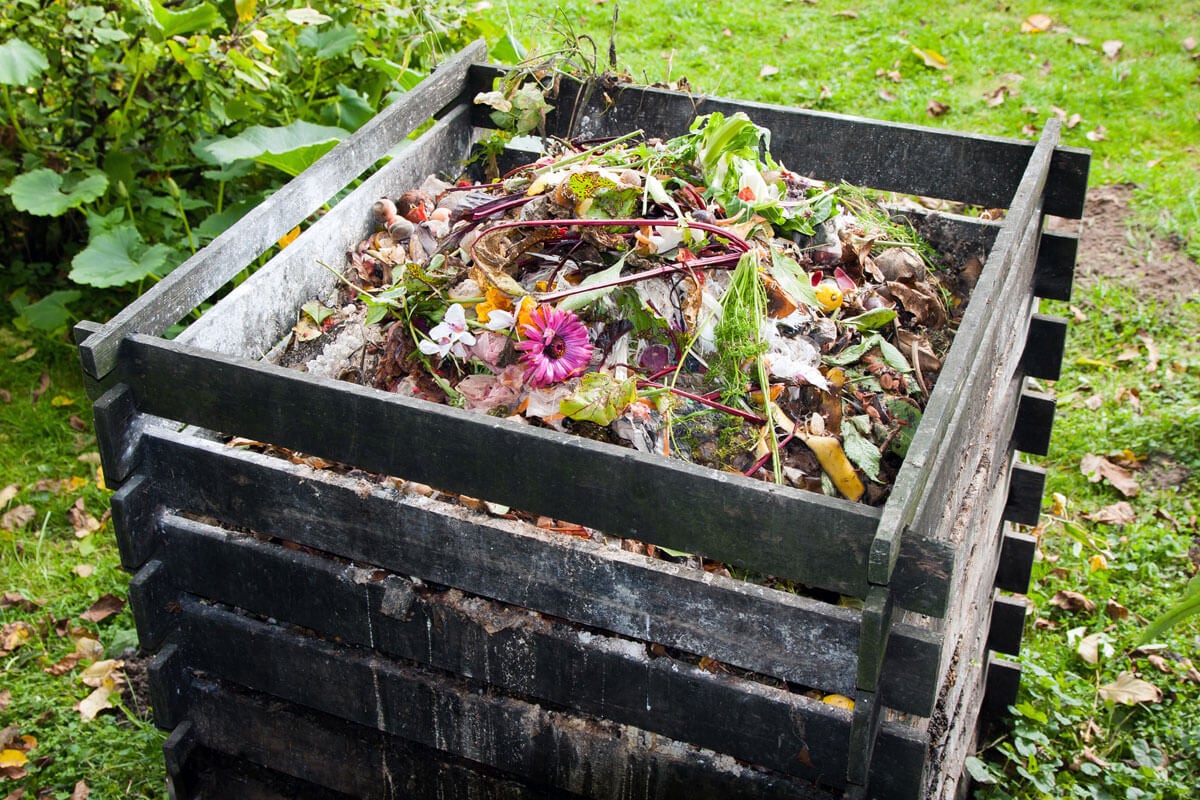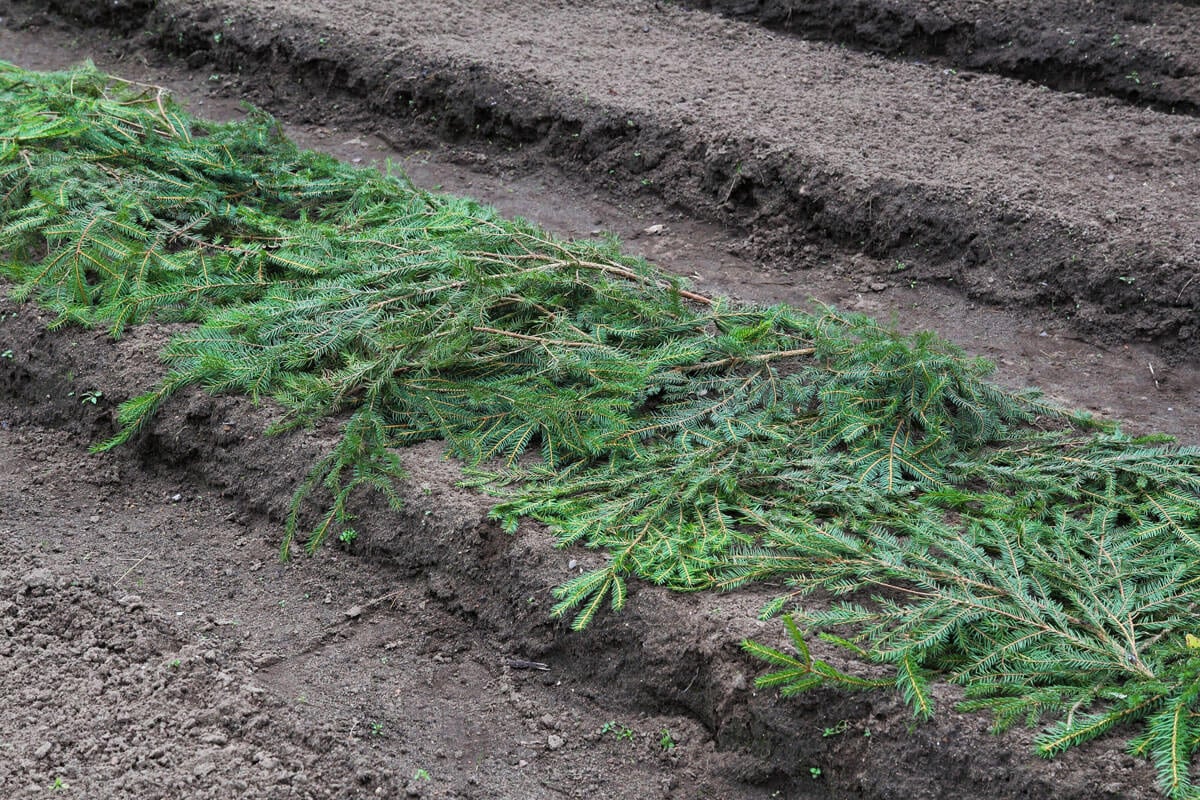As temperatures drop in Autumn, it’s time to put your garden to bed for the season. Doing so will protect your plants from damage or death due to cold, and reduce the amount of garden work you must do in the spring. Here are the things you need to do to prepare your garden for winter.
- Clear Debris, Equipment & Supplies
- Harvest and Rebuild Compost
- Test and Amend Your Soil
- Plant Trees, Shrubs and Perennials
- Cover Up Garden Beds
- Divide and Plant Bulbs
- Prepare Berries for Winter
- Prepare Perennials and Herbs for Winter
- Prepare Trees and Shrubs for Winter
- Turn Off and Clear the Irrigation System
- Protect Birds and Pollinators
- Clean and Maintain Tools and Equipment
Clear Debris, Equipment & Supplies
Preventing weeds, pests and disease in next year’s garden starts with good hygiene practices at the end of the season:
- Clear your vegetable garden beds of all spent plants and weeds, and compost them. However, put any seedy, diseased or pest-ridden plants into the trash or burn pile rather than the compost, to avoid spreading weeds, pests or diseases to next year’s garden. Leave overwintering vegetables like kale or cabbage and, if possible, cover with cold frames or row covers for continuous winter harvest.
- Rake your fallen leaves into low piles and run the mower over them to shred them. Use this mulch on your trees and perennial beds, or as fodder for your compost bin. If you don’t want to shred them, rake your leaves onto a large sheet or tarp, then drag and dump them into a corner of your yard to give pollinators like bumblebees some winter protection.
- Take down any stakes, cages, trellises, row covers or other equipment that remain in the garden. Clean off any soil or plant material, then stack and store them in your garage or toolshed.
- Wash, sanitize and store your seed trays and garden pots. This keeps mold, fungus, and potential disease from spreading to your next crop.
- Empty any outdoor planters or containers that might rust or hold water and crack during the winter. Store them upside down. If you can, bring them in till next season.
Harvest and Rebuild Compost
It’s likely that the material you composted over the summer is finished and ready to go. Use this rich, dark humus to amend your garden beds or fertilize lawns and landscaping.
By cleaning out your finished compost, you now have room for a new batch! Build your fall compost pile with shredded autumn leaves, grass clippings, or seed-free straw layered with spent plants from cleaning up your garden, kitchen scraps, and other wet, green matter.
Related

Test and Amend Your Soil
Fall is an optimal time to get a soil test done. A good soil test will tell you:
- Soil pH
- Levels of potassium (K), phosphorus (P), calcium (Ca), magnesium (Mg), and sulfur (S)
- Level of organic matter
- Lead content (Some soils near old homes have been contaminated with lead paint, and are not safe for growing food.)
To take a sample for a soil test, take a small trowel of dirt from 5-6 different areas of your garden (more, if your garden is very large), about 6 inches below the surface. You should collect about two or three cups of soil altogether.

Mix the samples well, then spread the mixture out on a tray to let it air dry. Remove stones and other debris. Once dry, bag up and send your sample to your local Cooperative Extension office. This list of extension offices in every state will help. If you garden organically, let the office know when you submit your soil sample.
Once you get the results, you will typically be given fertilizer recommendations. Fall is the best time of year to add soil amendments like compost, manure, bone meal, lime, kelp, or rock phosphate because this gives them time to start breaking down and becoming biologically active. It also saves you time during the busy Spring season!
After adding the recommended nutrients to your soil, add a couple inches of compost or composted manure on the top of your beds, then mulch or sow a cover crop (see below) to prevent winter rains from washing the nutrients out of your soil.
Plant Trees, Shrubs and Perennials
Fall is the ideal time for planting trees, shrubs and perennials because planting a month or two before a hard frost allows the roots to become established before winter sets in. Trees and shrubs planted in the fall are also better equipped to deal with heat, pests and drought the following season.
In Autumn, you can plant any shade, fruit or nut tree, blackberries, blueberries, garlic and shallots, asparagus, rhubarb, and daylilies, among other hardy perennials. Avoid planting tender, broad-leaved evergreens like rhododendrons, azaleas, boxwoods and hollies in the fall, because they will not likely survive winter cold and wind so soon after planting.
Cover Up Garden Beds
Covering and protecting your soil from the elements is vital to keeping it healthy and fertile for growing crops. Before winter, you should cover your empty garden beds so that you cannot see any bare soil using one of the following methods:
Mulch
Adding a thick layer of mulch atop your garden beds can help ease the transition into winter. Mulch protects soil from being washed away, conserves moisture, slowly adds nutrients and organic matter to your soil as it breaks down, and prevents weeds from sprouting in the Spring.
After amending your soil, cover your beds in a 1-3 inch thick layer of mulch. Good choices include:
- shredded leaves,
- dried grass clippings,
- seed-free straw (not hay),
- aged wood chips,
- pine needles,
- cocoa or hazelnut hulls,
- pine or spruce boughs,
- brown cardboard boxes or old wool rugs.
Whatever you choose, just make sure you use an organic, weed-free source. A poor source of mulch can poison your soil or fill it with noxious weeds.

Plant Cover Crops
A cover crop is like green compost growing in your soil. Cover crops help prevent soil erosion, break up compacted soils and increase organic matter in your garden beds. Cover crops can also mobilize minerals in the soil, fix nitrogen, and help sequester carbon from the atmosphere.
Best cover crop choices for home gardeners are nitrogen-fixing plants from the legume family, such as Berseem clover and field peas, or annual grasses such as oats or barley. These four crops are the easiest to turn into the soil in the Spring.
Scatter cover crop seed around your garden beds (like you’re feeding your chickens) at least one month before the first frost in your area, so you get as much growth as possible before freezing temperatures kill everything. The amount of seed to plant will vary by species, but generally, you’ll need 2 to 3 pounds of cover crop seed per 1,000 square feet of garden bed.
Cover large seeds like peas with one-quarter to one-half inch of soil or compost. Small seeds like clover should be left on the surface and lightly raked in. Spread a thin layer of straw over the bed to protect the area from wind and runoff.
After a hard freeze or snow, your cover crop will die and slowly compost throughout the winter, preventing erosion and adding nutrients to your garden. Any that remains can be mixed into the soil in the spring.
Install Row Covers or Cold Frames
If you plan to keep cold-tolerant crops like kale, cabbage and spinach going during the winter, you will need to install row covers or cold frames to protect them from freezing rain and snow.

Row covers and cold frames work like small greenhouses over your garden beds, protecting your winter-hardy plants so you can harvest them throughout the season (or give them a head-start in the Spring).

Divide and Plant Bulbs
- Fall is the optimal time to plant (or transplant) flowering bulbs like crocuses, daffodils, lilies, irises or tulips. (Fall is also the time when you should plant garlic.)
- If you have any flowering bulbs that appeared crowded or straggly during the growing season, Fall is also the time to dig up and divide them. Dig 4-8 inches away from the plant’s stems and leaves, carefully loosening the soil. Lift bulbs gently and separate some for immediate transplanting elsewhere in the garden.
- Once frost blackens the leaves of dahlias, gladioli, and cannas, carefully dig them up and let them dry indoors on newspaper for a few days. Then pack them in sawdust or shredded newspaper and store in a dark, humid spot at 40° to 50°F (5° to 10°C) until Spring.
Prepare Berries for Winter
Berries tend to be hardy perennials, but some do require fall pruning and care. In early to mid-fall:
- Cover strawberry beds with a thick layer of seed-free straw mulch.
- Prune summer-bearing raspberries, leaving six of the strongest brown canes for every 1 foot of the patch.
- Cut fall-bearing raspberries to the ground after they have borne fruit. New canes will come up in the Spring.
- Give blueberries and blackberries a thin layer of wood chip or pine needle mulch to protect them over winter.
Prepare Perennials and Herbs for Winter
Many perennials and herbs are tough, and just need a layer of mulch around their roots to protect them over the winter. A few though, like rosemary or lavender, might need some additional protection (or to be potted up and brought in) to survive the coldest temperatures in your area.
Most perennials can wait to be cut back until the spring, especially if they have lots of seedheads (like coneflowers or poppies) that the birds can enjoy all winter. However, there are some perennials you should cut back in Fall to avoid spreading diseases—especially bee balm, phlox, bearded irises, peonies, rudbeckia, and hostas—plus anything else that carried pests or disease in your yard during the growing season.
Wait to cut perennials back until the ground has frozen hard and the foliage has died, so you know the plants are dormant. Prune hard, leaving about 3 inches of stem above ground, and mulch with a thick layer of leaves, wood chips, or straw.
Prepare Trees and Shrubs for Winter
- Put a 3-inch layer of mulch around all your trees and shrubs to protect their roots for the winter. Wood chips or shredded leaves are excellent choices for this. Just make sure the mulch does NOT touch or pile up around the trunk of the tree, which can cause rot and disease.
- Do not prune trees and shrubs in the Fall, even if they look overgrown. Wait until they have lost all their leaves (if deciduous), and a few hard frosts have made them dormant for the winter. That way, you can see the structure of the branches more clearly, and your cuts will neither weep nor draw insects and disease.
- For young fruit trees, wrap the lower trunk of the tree with a pestproof tree wrap, which will prevent freezing and thawing injuries to the trunk, and stop mice and voles from gnawing on the bark during the winter.
- If you have young or delicate plants that could be harmed by heavy wind, snow and ice, encircle them with a cylinder of chicken wire fencing, or drive stakes into the ground at four corners around the plant, and wrap burlap or an old sheet around the stakes, securing it at the top, center, and bottom with twine. Fill the space between the plant and the barrier around it with straw or shredded leaves as insulation.

Turn Off and Clear the Irrigation System
Be sure to disconnect your hoses, sprinklers and irrigation systems from the spigot before the first fall frost so they don’t get damaged by freezing winter temperatures. In warmer climates, you can usually just disconnect the system from the hose spigot and allow the water to drain out. However, in colder climates, you will want to either blast all the water out of your irrigation system with an air compressor, or just bring everything inside for the winter.
Empty, wind and store your garden hoses in your garage or toolshed, along with any hose nozzles and sprinkler attachments they use. 5-gallon buckets work great for this.
Related
- Break the Ice Without Scorching the Earth: Non Toxic De-Icers
- How to Prepare Your Barn for the Winter
Protect Birds and Pollinators
- Keep bird feeders topped up. Birds especially appreciate fatty, high-energy foods (such as nuts or suet) during the cold months.
- Fallen leaves provides habitat, insulation, and protection for insect pollinators. Leave a small pile of leaves in a corner of your yard to give bumblebees and butterflies some places to hibernate.

Clean and Maintain Tools and Equipment
- Fix any broken things in your garden. If your hose or irrigation line is leaking, your raised bed has lost a side, or the doors are falling off your garden shed, now is the time to repair them.
- Bring in all garden tools and wash them thoroughly to remove dirt and debris. Remove any rust you see with sandpaper or a wire brush. Sharpen your hoes and shovels with a basic file, and use a whetstone to sharpen your pruners.
- Rub the surfaces of your metal tools with a rag coated in Canola oil. This will help protect the metal from oxygen and extend your tools’ lives for another year.
- Clean off any dirt, grass or plant debris, then drain the fuel tank on your lawn mower, weed whacker, and any other power equipment. Consult the owner’s manual for other necessary winter maintenance.
Now go and enjoy your Autumn season! After all that hard work, you deserve it!









